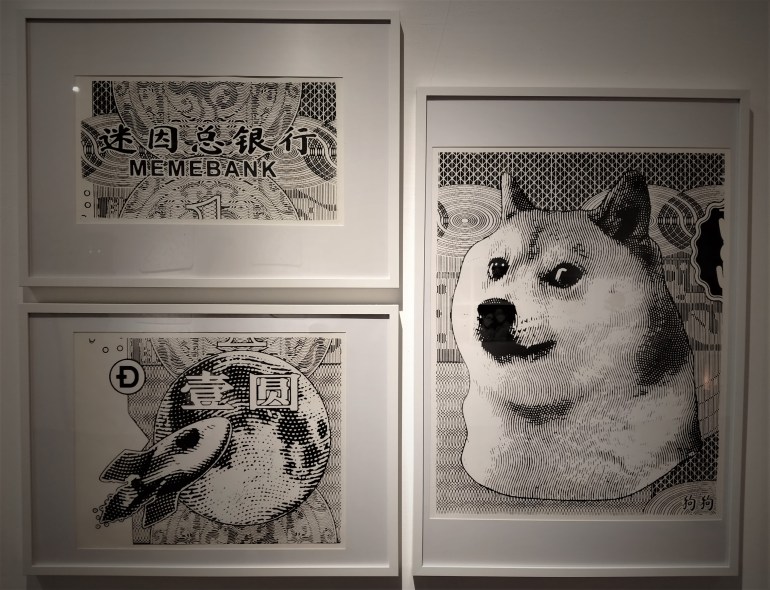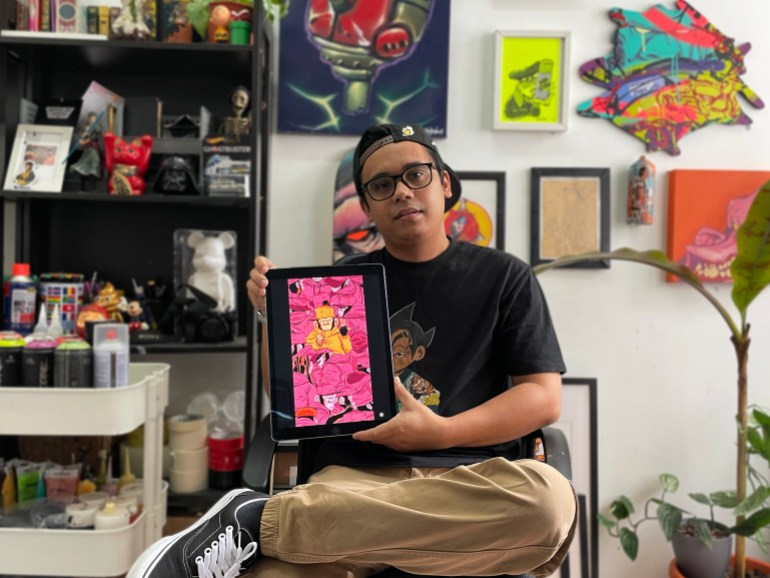Kuala Lumpur, Malaysia — Life-sized murals, quirky installations and every colour on the canvas: before the COVID-19 pandemic closed art and performing spaces in March 2020, the art festivals and galleries of the Malaysian cities of Kuala Lumpur and George Town provided a lifeline, and inspiration, to the country’s artists.
But with the disruption of the past 20 months, many have struggled to survive as full-time, “physical” artists, and have been forced to move out of their comfort zones.
Some have ventured into the newly emerging world of non-fungible tokens (NFT) and cryptocurrency.
NFTs are unique digital assets designed to represent ownership of a virtual item: unlike Bitcoin and other cryptocurrencies, NFTs cannot be exchanged like for like with other NFTs, making them scarce, and driving up their value.
This concept perfectly applies to collecting artworks and has started driving an unprecedented trend of digital consumerism: back in March, American digital artist Mike Winklemann, known as Beeple, sold an NFT of his work Everydays: The First 5000 Days for a staggering $69m through prominent British auction house Christie’s.
In Malaysia, the idea of NFT art incubated as a fun pastime for graduates of design, multimedia, engineering and architecture. It was popularised by Filamen, a Kuala Lumpur-based collective of multidisciplinary digital creatives who launched the Seni Kripto (“Cryptoart” in Malay) exhibition in April 2021 at their physical space Digital Art Gallery on the campus of the University of Malaya.
The Malaysian art scene quickly picked up on the potential of NFTs, launching the first Crypto Art Week in July, and creating Pentas.io, the first local NFT marketplace. It has already earned some local artists the cryptocurrency equivalent of millions of Malaysian ringgit.
New concept of art
“NFT in Malaysia has seen significant growth this past year,” Mumu the stan AKA Munira Hamzah (Moon) of Malaysia NFT told Al Jazeera. This new non-profit organisation and digital gallery supports Malaysian artists in the NFT scene, minting funds and providing educational materials and peer support to empower and uplift Malaysian art in the global scene.
“Earlier in the year, you could probably count the number of Malaysian artists actively minting and selling NFTs on one hand. That number increased steadily to hundreds over several months, and now we are probably in the thousands,” said Moon.
NFT artworks by Malaysian artists span the range of 3D animations, Internet memes, and illustrations inspired by the multiethnic culture of the Southeast Asian nation.
Moon says the growth of the NFT scene has changed the way artists in Malaysia traditionally make a living – from commissioned artworks – offering “newfound confidence as well as a source of income that doesn’t rely on client’s requests, but rather on what artists want to personally achieve creatively”.
For some of them, NFTs have brought back the joy into art.
“It gives me the opportunity to expand my creativity, display [my work] as I wish, track copyright ownership and maintain records of creation,” Penang-based artist Kenny Ng told Al Jazeera.
To others, NFTs have given a concrete opportunity to make staggering profits in Ether, the cryptocurrency that is the prime asset of Ethereum, the decentralised, open-source blockchain with smart contract functionality where NFTs are traded.
Earlier in September, Kuala Lumpur-based graffiti artist Abdul Hafiz Abdul Rahman, better known under the name of Katun, made headlines for selling two of his NFT collections in less than 24 hours for 127.6 ETH – the equivalent of 1.6 million Malaysian ringgit ($400,000). It was the most expensive batch of NFTs ever sold by any Malaysian artist in one release.
“It’s very clear to see that, if done properly, the money gained can truly make a difference for any Southeast Asian artist, as crypto is growing exponentially on a daily basis,” Katun told Al Jazeera.
But even if NFT sounds like a get-rich-quick scheme, at least in Malaysia it has grown to be more of a progressive, helpful community. For example, Katun founded 4 Stages, a digital platform with the aim of bringing Southeast Asian artists together.
“There are so many talented artists here with not enough exposure to the rest of the world,” Katun told Al Jazeera, adding that the fast growth and global reach of NFT will be key to propelling both the presence and the monetary gains of Malaysian artists well beyond the geographical and economic constraints of the country’s small physical art market.
Skeletons in the closet
The advantages provided by the use of NFT and cryptocurrency are evident in a developing region where artists abound, but art spaces and freedom of expression are limited.
The catch, however, is that these digital artworks are paid for with cryptocurrencies, whose mining is reported among the most carbon polluting enterprises in the world today.
 Memebank’s Doge to the Moon print, which pokes fun at Tesla CEO Elon Musk’s plan to fund a space flight by selling DOGE coin [Marco Ferrarese/Al Jazeera]
Memebank’s Doge to the Moon print, which pokes fun at Tesla CEO Elon Musk’s plan to fund a space flight by selling DOGE coin [Marco Ferrarese/Al Jazeera]In other words, many of the websites helping artists sell NFT artworks, such as the popular OpenSea, are based on the Ethereum blockchain, which is very ecologically taxing by design.
According to research by digital artist Memo Akten published on the website CryptoArt.wtf, “selling just a single-edition artwork on Ethereum has a carbon footprint starting at around 100 KgCO2, which is equivalent to a one-hour flight.”
“I was hesitant at first, but then I did a lot of research and spoke to a lot of people, especially technologists, who really understand blockchain and then my views shifted,” Kuala Lumpur-based artist Red Hong Yi, who’s known as Red, told Al Jazeera.
Hailing from Kota Kinabalu in the Borneo state of Sabah, Red established herself internationally by creating portraits of Chinese celebrities including Ai Weiwei and Jackie Chan that she realised with a selection of everyday objects ranging from used teabags to bundles of chopsticks, eggshells and socks.
Her striking work Climate is Everything was the result of creating and burning a map of the world made with 50,000 green-tipped matches stuck on a whiteboard.
Few anticipated that with such a background even Red would want to have a go at NFT technology, but she debuted earlier this year with Doge to the Moon – a spoof banknote that celebrates and pokes fun at Tesla CEO Elon Musk’s idea of funding the upcoming launch of the Doge-1 satellite entirely with DOGE coin, a fictional cryptocurrency whose mascot is a Shiba Inu dog.
Doge to the Moon was minted and auctioned on the Binance NFT Marketplace for two weeks, with a top bid of 36.3 ETH (about 320,000 Malaysian ringgit ($75,500). The sale helped Red co-organise 1000 Tiny Artworks, a physical exhibition of artworks by 100 Malaysian artists that will take place in Kuala Lumpur between December 17 and 19.
Doge to the Moon is also part of Red’s latest NFT project, Memebank, a spoof central bank with six banknotes inspired by the Chinese yuan, US dollar, Japanese yen, British pound, Singapore dollar and Malaysian ringgit, and addresses the rather complex issue of “how economists have warned about the dangers of inflation when central banks print money continuously,” Red told Al Jazeera.
Unlike most other NFT projects, Memebank is not just a digital product. Each buyer gets a 1/1 canvas print of the artwork, and their own physical copper plate of their chosen banknote, enabling them to print as many copies as they like.
Turning down the carbon volume
A reason for believing in NFT art is that this digital space is moving fast, with the creation of new, low energy-consuming blockchains like Tezos, which runs on a system called “Proof-of-Stake” (Pos), and is expected to drastically decrease the current carbon effects of NFTs. “[Tezos] is basically the same as using your PC on a general daily basis (stake nodes),” said Katun.
 Kuala Lumpur-based artist Katun with Apes Stand Strong, one of the two NFTs that earned him a fortune [Image courtesy of Katun]
Kuala Lumpur-based artist Katun with Apes Stand Strong, one of the two NFTs that earned him a fortune [Image courtesy of Katun]“People will not stop taking flights even if planes have carbon footprint, because it solves time and distance issues. Blockchain, the technology supporting cryptocurrency and NFTs, solves trust issues by providing transparency, so we do not need an intermediary while transacting. It gives control back to the majority. The current system is in the hands of a few,” Ivy Fung, a Sabahan Blockchain advocate and trainer based in Kuala Lumpur, told Al Jazeera.
“Many researchers are working towards [ways of] reducing energy consumption, and some are already implemented, for example, using a more energy-efficient mechanism, Pos, where the trust is built on the stake pledged, rather than the computing power which consumes a lot of energy.”
What remains uncertain is whether NFT art will be able to distinguish itself after the novelty wears out. After all, the rules for success are in many ways similar to the traditional path of art gallery exhibitions and hard to crack collector markets.
“It’s like every minute a new NFT is created and uploaded,” Kenny Ng told Al Jazeera. “[Success still] really depends on the effort of the artists themselves to self-promote and become visible.”
Credit: Source link
















 Bitcoin
Bitcoin  Ethereum
Ethereum  Tether
Tether  Solana
Solana  XRP
XRP  Dogecoin
Dogecoin  USDC
USDC  Cardano
Cardano  Lido Staked Ether
Lido Staked Ether  TRON
TRON  Stellar
Stellar  Avalanche
Avalanche  Toncoin
Toncoin  Shiba Inu
Shiba Inu  Wrapped stETH
Wrapped stETH  Wrapped Bitcoin
Wrapped Bitcoin  Polkadot
Polkadot  Chainlink
Chainlink  Bitcoin Cash
Bitcoin Cash  WETH
WETH  Sui
Sui  Pepe
Pepe  LEO Token
LEO Token  NEAR Protocol
NEAR Protocol  Litecoin
Litecoin  Aptos
Aptos  Uniswap
Uniswap  Wrapped eETH
Wrapped eETH  Hedera
Hedera  Internet Computer
Internet Computer  Cronos
Cronos  USDS
USDS  POL (ex-MATIC)
POL (ex-MATIC)  Ethereum Classic
Ethereum Classic  Render
Render  Bittensor
Bittensor  Artificial Superintelligence Alliance
Artificial Superintelligence Alliance  Ethena USDe
Ethena USDe  Arbitrum
Arbitrum  Bonk
Bonk  Cosmos Hub
Cosmos Hub  WhiteBIT Coin
WhiteBIT Coin  Filecoin
Filecoin  Dai
Dai  MANTRA
MANTRA  dogwifhat
dogwifhat  OKB
OKB